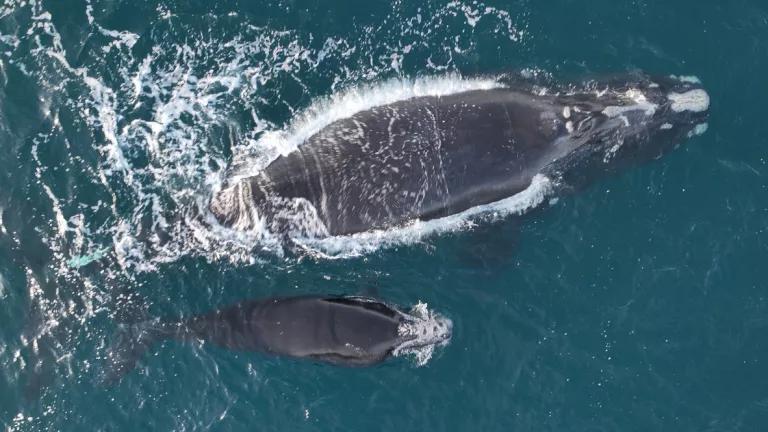
Posing in front of the State Capital Building in Helena, Montana, prior to testifying at a bill hearing.
Guest blog written by Sofia Deer
One thing I did not expect in joining NRDC as their Winter Wildlife Intern was the deep soreness I’d feel in my forearms and digits—not from typing up page after page about native carnivores, current legislation, and the like—but from pounding fiberglass posts into frozen ground beneath three feet of packed snow. The soreness was the aftermath of a “turbo fladry” project that I joined in western Montana. Turbo fladry is a type of electrified flag fencing that relies on wolves’ neophobia (a fear of new objects or conditions in their environment) to prevent livestock depredation.
The video above shows clips from turbo fladry installations.
I still have never seen a wolf in the wild, so I can’t say I know how they bound across this landscape, but I have gained some insight on Montanans’ perspectives of them during my time here. The most striking observation I made through my work at NRDC is how it’s far too easy for individuals to take a myopic view of wolves and their impacts.
Encouraged by my coworkers Jenny and Zack, I joined them in attending multiple legislative hearings that concerned carnivores (these hearings are an excellent resource for understanding sentiments on difficult subjects.) The overall message I extrapolated from ranchers and sportsmen in these hearings was the same regardless of the bill’s intent: wolves need management because they are a direct threat to struggling ungulate populations and livestock. Wildlife advocates had an opposite message: population numbers of ungulates aren’t dropping; they’re simply redistributing differently across the state—a common behavioral response when they’re faced with a new predator, like wolves—and are mainly dying from exposure, disease, human-caused habitat loss, and other environmental reasons.
Similar things were said about livestock depredations. Some stated that wolves that depredate livestock are a nuisance to Montana cattle and sheep producers. Any depredation negatively affects ranchers’ livelihoods, and I empathize with the ranchers who feel they are at war with a carnivore that hasn’t been present on this land for generations (wolves were extirpated from the region and then reintroduced to Yellowstone National Park in 1995).
However, wolves existed in Montana long before settlers and livestock did. Estimates put their historical populations in the tens of thousands in Montana alone until the arrival of western agriculture in the 1800s led to habitat loss and, subsequently, livestock depredations. Those depredations provoked a decades-long bounty program that pushed wolves to the point of extirpation in Montana in the 1930s. Gray wolves recovered somewhat with protection under the Endangered Species Act in 1974 and reintroduction to Yellowstone, but they still only cover less than 20% of their historical range in the lower 48. So, although a rancher today may claim that their presence is unnatural within the breadth of their own lifetime, a wolf’s generational presence on this land is longer-standing than any person whose ancestors settled here after European colonization.

A wolf pack socializing.
Photo: CC0
The effect of wolf depredation on any individual livestock operation can be significant, and not every loss to wolves is discovered or reported. In general, though, wolves account for only a tiny fraction of livestock losses overall. In early March, the Humane Society of the United States released a report detailing the impact wolves had on livestock in 2015 via data from the U.S. Department of Agriculture - Animal and Plant Health Inspection Service (USDA-APHIS) and Fish and Wildlife Services (FWS). According to the report, the USDA found that wolves killed only 1.03% of the total number of cattle that died in Montana in 2015. For sheep killed by wolves, that percentage was even less: 0.40%. Even though the USDA’s data is inflated (you can read why in the report), it underpins a point—wolves aren’t the menacing threat that they are often made out to be. They’re simply reacting as they did to habitat loss two hundred years ago, and only have minimal consequence in the bigger picture.
I am finishing up my NRDC internship as the federal government is proposing to remove Endangered Species Act protections from wolves across much of the United States (the northern Rockies population was previously delisted). It is a peculiar experience to be post-pounding your arms into Jell-O in the name of non-lethal, human-wolf conflict prevention while the federal government proposes stripping gray wolves of their protections nationwide. The timing made me seriously consider the things we do to and for wolves. But if NRDC’s commitment to maintaining relationships with groups whose stances often conflict with our own has taught me anything, it is the importance of recognizing individual perspectives of localized wolf conflicts, while also zooming out from the immediate issue at hand.

Pounding posts while installing a line of turbo fladry.
I am perpetually grateful for the guidance from Jenny and Zack, the support from Lance, and the lessons I learned about the tricky and nuanced nature of wildlife conservation while at NRDC. There are many more aspects of my internship I’d love to reflect on (Montana Trapping Advisory Council meetings, testifying at the legislature, Beef the office Bulldog), but wolves win out here, at least.

Guest blog writer Sofia Deer, in Sweden.
Sofia Deer received a bachelor’s degree in Environmental Humanities from Whitman College in 2017. When she’s not geeking out about wildlife, she’s either frolicking in the snow around Bozeman or in her natural habitat, Sweden (her Mother's homeland). She was the Wildlife Intern at NRDC’s Northern Rockies Office in Bozeman, MT this winter.



